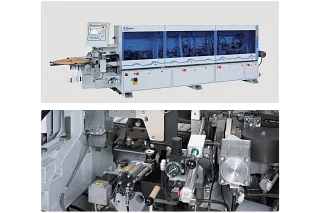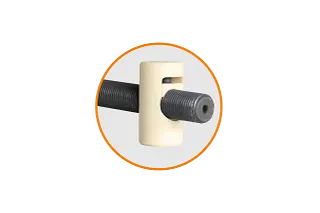Change Language :

For perfect edges: Brandt edge banding machine

Application Story
- What was needed: Lifelong freedom from clearance of the adjustment unit and thus precise glue application without maintenance
- Requirements: No sticking due to the fine wood dust, high precision, absolute freedom from lubrication and maintenance, flexibility in production
- Products used: Anti-backlash trapezoidal lead screw nut, trapezoidal lead screw made of stainless steel
- Success for the customer: The clearance-free and maintenance-free nature of the newly developed adjustment system has convinced Brandt so much that they are thinking of basically converting all lead screws in the machines to the maintenance-free anti-backlash system. "That way we can further increase the reliability of the machines," says Ralf Garnjost with confidence. In the edge banding machines, various tribo-optimised polymer bearings are also proving themselves in special shapes. "Freedom from lubrication pays off in all areas. For us lubrication and dust are incompatible at all points."
Dry-running and clearance-free dryspin lead screw drives ensure precise glue application
What happens when fine and the finest wood dust encounter the lubricant? Adhesion is inevitable. The functionality of woodworking machines can be permanently impaired. For this reason, a medium-sized company relies on lubrication-free and maintenance-free lead screw drives with anti-backlash nuts in its new development of an adhesive application system for edge banding machines, which ensure lifelong zero clearance of the adjustment unit and the precise application of glue.
Glue application with precision
The latest developments include the QA 45 glue application system, which is available as an option from a certain machine size. It is characterised by, among other things, short heat-up times as well as fast changeover options and thus a high degree of flexibility when processing a wide variety of adhesives, edges and board materials. "With the system, we want to create the possibility of automating adhesive application. In this way, we offer our customers more ease of use. Otherwise, the adhesive is applied more or less by sight," says Ralf Garnjost, describing the original situation. "Our goal was to create an inexpensive, yet structurally sound solution that would stand the test of time in everyday operations."

Besides the automatic cleaning function, one of the innovations of the new glue application system is a clearance-free adjustment, which was implemented in collaboration with the company igus GmbH, Cologne. At the heart of this adjustment is the anti-backlash nut, which was presented as a standard product at the Hannover Messe Industrie 2010. "Backlash" refers to the play at reversal, which is caused in a lead screw drive by the axial clearance.
The anti-backlash lead screw nuts offer many advantages:
- Reduction of backlash over the entire service life
- Permissible wear is ensured
- Non-lubricated and extremely dirt-sensitive lead screw drive
- No adhesion of dirt and dust to lubricants
In the glue application system, anti-backlash lead screw nuts have been used for metric threads as a special development for several months: Lubrication-free, vibration- and noise-dampening, they ensure maximum precision.
Precise travel
"All the usual solutions tend to be susceptible to maintenance in everyday operation due to the difficult environmental conditions in woodworking," explains mechanical engineer in the design department, Thorben Fritz, who was largely responsible for the development of the adjustment unit. "Due to our many years of experience with tribo-optimised plain bearings from igus in our machines, we were convinced right from the start that we could guarantee precise format adjustment in the long term with lubrication-free machine elements." In the area of lead screw systems - up to ten axis units cover the most diverse work in an edge banding machine - the edge specialist has so far relied on brass nuts, which are, however, not backlash-free. Due to the existing backlash, the desired position is not always hit, the repeatability is poor.
With the help of the adjustment, the adhesive application on the edges is dosed. If the travel is not accurate, there are deviations of several tenths, which reduces the quality of the adhesive application. For this reason, clearance-free adjustment was very important in the development of the application system. Classic solutions such as lead screw nuts braced against each other have been quickly discarded. "These are manifold design approaches that are not only very complex, but also require a relatively high drive torque of the actuator," explains Ralf Garnjost. "In contrast, we try to drive our axis systems with a relatively low torque." The low coefficients of friction of the new lead screw nut system provide the required low drive torque.
General conversion to maintenance-free linear systems and plain bearing solutions


